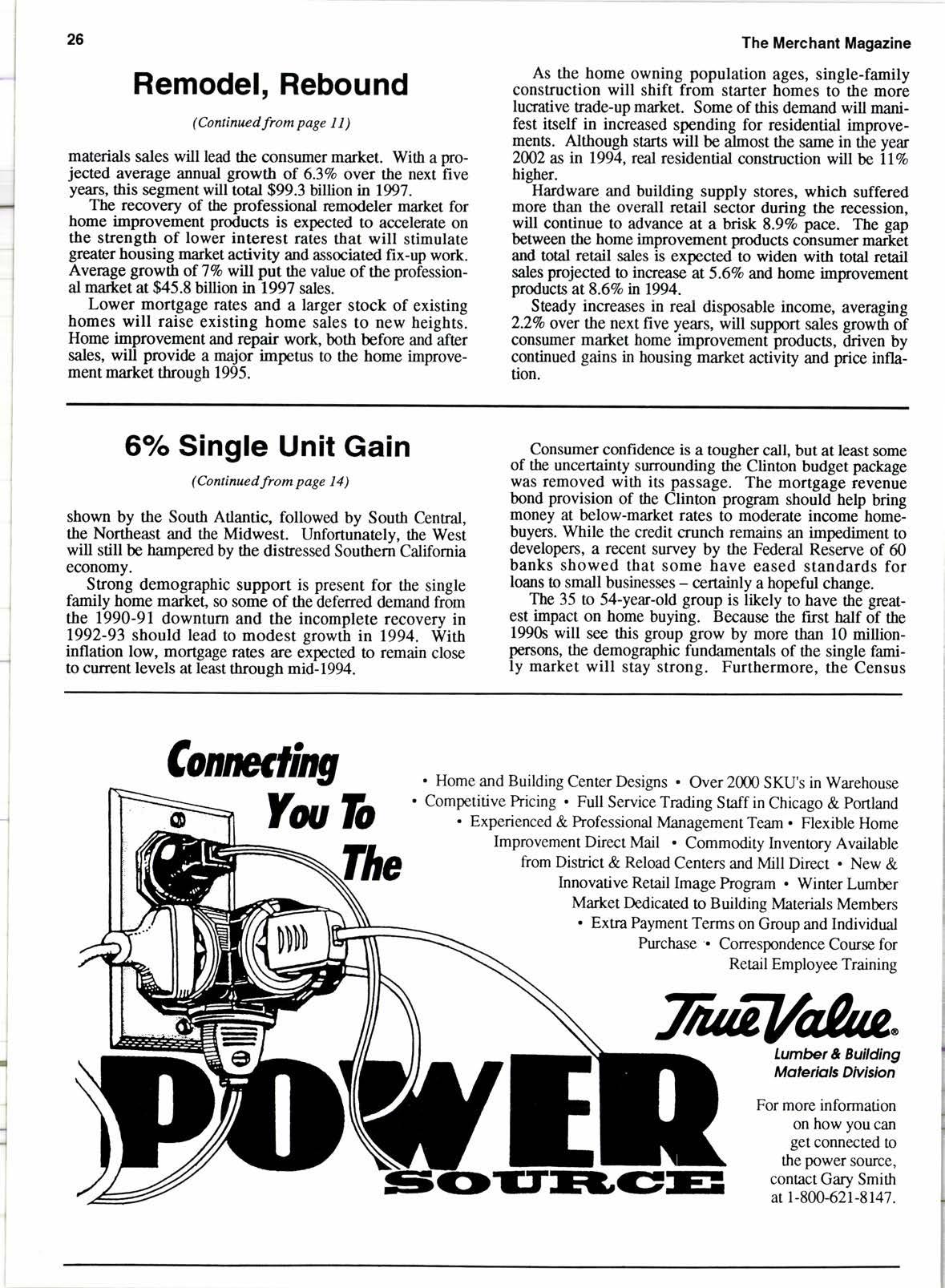
3 minute read
Comutittg Youh
As the home owning population ages, single-family construction will shift from starter homes to the morb lucrative Eade-upmarket. Some of this demand will manifest iself in increased spending for residential improvem€nts. Although starS will be abnost the same in the year 2ffi2 as rn 1994, real residential construction wrllbe ll4o higher.
Hardware and building supply stores, which suffered more than the overall retail sector during the recession, will continue to advance at a brisk 8.9Vo pacf-. The gap between the home improvement products consumer maiket and total retail sales is expected to widen with total retail sales projected to increase at5.6Vo and home improvement producn at8.64o in 1994.
- _Steady increases in real disposable income, averaging 2.2Vo over the next five years, *ilI support sales growth oT con$mer ma*et home improvement products, driven by continued gains in housing market activity and price inflation.
Consumer confidence is a tougher call, but at least some of the uncertainty surrounding the Clinton budget package was removed with its passage. The mortgage revenue bond provision of the Clinton program should help b'ring money at below-market rates to moderate income homebuyers. While the credit crunch remains an impediment to developen, a recent survey by the Federal Reserve of 60 banks showed that some have eased standards for loans to small businesses - certainly a hopeful change.
Tbe 35 to 54-year-old group is likely ro have the greatest impact on home buyrng. Because the first half of the 190s will see this grcup grow by more than 10 millionIlersqls, the demographic fundamentals of the single fami- ly market will stay strong. Furthermore, the Census
. Home and Building Center Designs . Over 2000 SKU's in Warehouse Competitive Pricing . Full Service Trading Staff in Chicago & portland
Experienced & Professional Management Team . Flexible Home Improvement Direct Mail . Commodity Inventory Available from Disrict & Reload Centers and Mill Direct New & Innovative Retail Image Program . Winter Lumber Market Dedicated to Building lvlaterials Members . Extra Payment Terms on Group and Individual Purchase . Conespondence Course for Retail Employee Training Lumber& Buildng Molerials Dlvlslon ft-3(E-!
For more information on how you can get connected to the power source, conactGary Smith ar 1-800621-8147.
December 1993

Bureau has raised its population estimates to take into account greater growth in immigration, boosting projections for housing demand in the years ahead.
A total of 175,000 units projected this year will be the first advance since 1986 for the depressed multifamily housing secttr. Given the new focus of the Clinton Administration, some support from 0ax credits for low income rental housing can be expected. A low 97o increase of 190,000 units can be expected in 1994.
Contract value of single family houses to be built in 1994 is projected to be $116,225 million, up 97o from 1993. Multifamily housing contract value will & $12,27 5 million, up lD%o from 1993. Total contract value for residential buildings will be $128,500 million, an increase of 9Vo froml993.
NAFTA Aids Lumber Exports
Both western and southern lumber producers are expecting good things from the North American Free Trade Agreement (NAFTA) approved last month by the U.S. House of Representatives and Senate.
Due to go into effect early next year with approval by the Mexican Senate urd Canada the trade pact is anticipated to have a positive impact on development of Mexican lumber markets. Already the U.S.'s second largest export market for both softwood lumber and structural panels, Mexico bought 190 nillion board feet of softwood lumber and 163 million square feet of panels from across the border in the first half of this year. More than half of the 409 million board feet of lumber sold to Mexico in 1992 was ponderosa and other pines from the westem states.
Duties of ll-l5%o on U.S. framing lumber entering Mexico will end Jan. I with l0-207o duties on structural panels being phased out over the next 10 years. A 7.57o duty on panel products shipped from the U.S. to Canada will phase out over the next five years. Litt]e change is expected in lumber tnade between the U.S. and its northern neighbor.
NAFTA will not altet the 6.5Vo countervailing duty presently being collected on Canadian softwood lumber (see related story p. 22).
Although Mexico favors masonry for residential construction, industry representatives anticipate the need for low cost housing will increase lunber sales.










